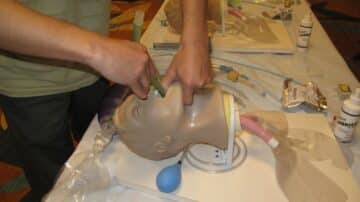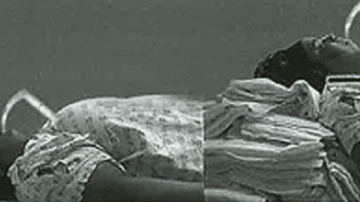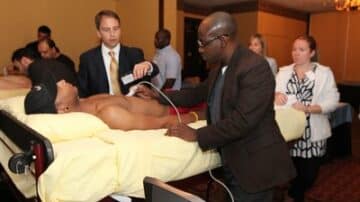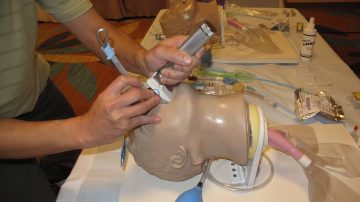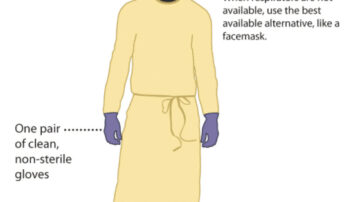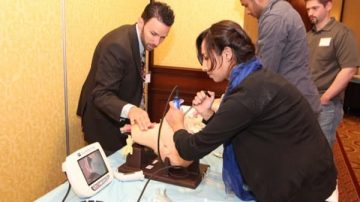Laryngeal airway masks are an invaluable tool in effective airway management, especially in emergency situations. They are particularly helpful during “can’t intubate, can’t ventilate” scenarios as they are easy to insert for airway rescues. They can be blindly placed and…
Read MoreFor procedures involving lumbar punctures , sonographically guided lumbar punctures (SGLPs) have a higher propensity of being chosen when dealing with obese patients. This is based on findings of a randomized controlled trial conducted in 2007. The main takeaway from…
Read MoreWhat is conscious sedation? Conscious sedation, also known as procedural sedation, is a common practice in emergency departments for patients undergoing painful or anxiety-provoking procedures. It is intended as a less invasive method. Generally, those who undergo this type of…
Read MoreMore Articles – Arterial line, Cardiovascular diseases, Central line, Chest Tube, Emergency Procedures, Endotracheal Intubation, Events, FAST Exam, Intraosseous line, King Tube, Laryngeal Mask Airway, Lumbar Puncture, Mechanical Ventilation, Medical General, medical procedures, Needle Decompression, Paracentesis, Procedural Sedation, RUSH Exam, Thoracentesis, Ultrasound-Guided Peripheral IV
Physicians, physician associates (PAs), and nurse practitioners (NPs) need to be adept in a range of essential medical emergency procedures that they must perform in an inpatient settings. These bedside procedures are accomplished readily, but only if you have the…
Read MoreMorbidly obese patients can pose numerous challenges when it comes to airway management. Morbid obesity can make vascular access more difficult and you need good vascular access prior to any attempts at safe airway management. In addition, morbid obesity can…
Read MoreFor decades the mantra for procedural education in medicine has been “see one-do one-teach one”. Those of us who learned bedside procedures and point-of-care ultrasound by this model understand that this approach does not optimize safe and competent performance. At…
Read MoreMore Articles – Cardiovascular diseases, Central line, Endotracheal Intubation, Featured Procedure, Gastrointestinal diseases, Glidescope Intubation, King Tube, Laryngeal Mask Airway, Lumbar Puncture, Mechanical Ventilation, Medical General, medical procedures, Paracentesis, Respiratory diseases, Thoracentesis
Simulation-based procedural training has been shown to improve procedural competence, safety, operator confidence and most importantly patient safety for every bedside procedure studied. Now, a new systematic review and meta-analysis confirms that simulation-based training in airway management improves procedural competence…
Read MoreA number of additional factors must be considered with airway management in COVID-positive patients. Hospital Procedures Consultants (HPC) can provide simulation-based training to prepare providers for airway management in COVID-positive patients. The first essential consideration is to place the patient into a…
Read MoreThe Society of Airway Management recently issued guidelines for Difficult Airway Management in COVID-19 patients. The SARS CoV-2 (COVID-19) virus is extremely contagious via respiratory droplets and therefore extra precautions are needed for airway management in severe COVID-19 infection. Airway…
Read MorePatients may have anatomically difficult airways or physiologically difficult airways. Both anatomical and physiological factors can lead to peri-intubation complications. My goal for this blog is to describe the factors that may contribute to an anatomically difficult airway and clinical…
Read MoreRemember the Laryngeal Mask Airway When You Can’t Intubate! As a hospitalist who also works in the ICU, I am often the first responder to respiratory emergencies. Frequently under these circumstances, you have a chaotic environment and a less than…
Read MoreKing Tube Airways are Excellent Rescue Airways for Both EMS and Medical Personnel If you are faced with a patient who needs a secure airway and respiratory stabilization, I still believe that endotracheal intubation is the airway of choice. Nevertheless,…
Read MoreIn prior randomized trials, the incidence of intracerebral hemorrhage (ICH) was significantly lower with the new oral anticoagulants (NOACs) than with warfarin (Blood 2014; 124:1968). However, it remains unclear if clinical outcomes are similar when ICH does occur with different…
Read MoreRecently, a retrospective review of over 14,000 adult patients who underwent general anesthesia were assessed. A multivariable analysis was used to determine risk factors of difficult laryngeal mask airways (LMA). The following four risk factors were identified: male gender, age…
Read MoreA systematic review found no significant missed injuries in obtunded blunt trauma patients who had normal CT imaging of their cervical spines. Given the significant morbidity and mortality associated with missed traumatic cervical spine injuries, patients in whom a reliable…
Read MoreCategories
- ACLS (1)
- Arterial line (33)
- Cardiovascular diseases (77)
- Central line (55)
- Chest Tube (39)
- Dermatology (4)
- Emergency Procedures (138)
- Endocrinology (6)
- Endotracheal Intubation (36)
- Events (24)
- FAST Exam (12)
- Featured (112)
- Featured Procedure (42)
- Gastrointestinal diseases (32)
- Ginecology (3)
- Glidescope Intubation (21)
- Hematology (33)
- Hospital Procedures (85)
- Infections (32)
- Intraosseous line (8)
- King Tube (27)
- Laryngeal Mask Airway (18)
- Lumbar Puncture (36)
- Mechanical Ventilation (34)
- Medical General (95)
- medical procedures (258)
- Needle Decompression (6)
- Nephrology (11)
- Neurological diseases (12)
- Oncology (4)
- Paracentesis (32)
- Pericardiocentesis (3)
- Procedural Sedation (19)
- Respiratory diseases (85)
- RUSH Exam (8)
- Thoracentesis (37)
- Traumatology (24)
- Travel (27)
- Ultrasound-Guided Peripheral IV (13)

